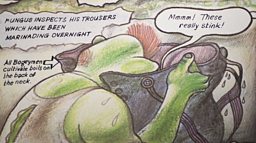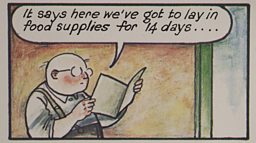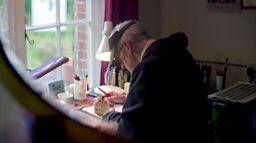Raymond Briggs: The iconic illustrator unafraid to tackle tragedy
11 August 2022
It was announced yesterday that Raymond Briggs had died at the age of 88. In tribute to the celebrated author and illustrator, the documentary Raymond Briggs: Snowmen, Bogeymen & Milkmen and the feature-length animation Ethel and Ernest, inspired by the lives of his parents, are both now available to watch now on iPlayer.

A retreat into darkness
In the space of just over two years in the early 1970s, Raymond Briggs lost both his parents and wife to cancer.
This is the way he does it, keeping the world away, pretending to be grumpy, and pouring all of that emotion into the workRobin Shaw
For Robin Shaw, who has directed a number of animations based on Briggs' books, there was a clear impact on his work.
He argues: "I wonder what would have happened if he hadn't had that loss, the way he had it. If you look at what he was doing before that, it's very different from what came after.
"This is the way he does it, keeping the world away, pretending to be grumpy, and pouring all of that emotion into the work."
After this devastating period Briggs threw himself into creating a book that was simultaneously dark and joyous, Fungus the Bogeyman. This creature, whose job is to scare humans, lives in a disgusting world full of snot and slime.
Unusually for a children's story, Fungus is having an existential crisis about his purpose as an individual, thinking thoughts which question the meaning of life, like "Not to reason why... not ask questions... just keep bogling away".


A clean break

After writing Fungus the Bogeyman, Briggs had the desire to create something very different in tone and style. The result was a book which catapulted him to a much greater level of recognition: The Snowman.
Having taken you through that wonderful relationship, he doesn’t shy away from death and the inevitability of lifeNick Park
Briggs says: "It was done as a reaction. I'd been two years immersed in all this slime and muck and wanted to do something different. Something lighter and quicker, less laborious, no words, just for the sake of a change."
His long-time editor, Julia MacRae, felt overwhelmed with emotion when Briggs first showed her the work.
She recalls: "He didn't like to be in the room when I was looking at his work, he'd go outside. He came back in and he found me in floods of tears and said, 'You don't like it?' and I said, 'Raymond, they're just tears of pure joy because it's just so beautiful'."
The book, first published in 1978, feels as if it was drawn by a child as Briggs drew with coloured pencils. It went on to form the basis for an animated film of the same name that was released in 1982, although there is no reference to Christmas in the book. (Briggs initially saw this addition as "corny and twee" but he admitted "it worked extremely well".)
Wallace and Gromit creator Nick Park recalls the thrill of seeing the famous flying sequence when he was a film student.
Park says: "They only had a clip ready and they showed it as a treat at the London Film Festival. I remember hearing about it and I was so thrilled to see it. For me it was like a dream come true - I was just so hoping it would reflect his original comic book artwork and it did. It was a real groundbreaker."
It might be a children's story but it doesn't shy away from life being temporary, as is reflected in the ultimate demise of the Snowman. Park adds: "At the end there is that harsh reality of what happens to a snowman, and having taken you through that wonderful relationship that developed, he doesn’t shy away from death and the inevitability of life."
Walking in the Air on Top of the Pops

While Peter Auty performed the version of Walking in the Air that featured in The Snowman film, Aled Jones performed the version that was released as a single in 1985.

A terrifying time to be alive

As tragic as the conclusion of The Snowman might feel, Briggs upped the ante considerably with his 1982 book When the Wind Blows.
You had these two superpowers going head to head - they had their fingers virtually on the trigger... I don’t know how we all lived with it at the timeRaymond Briggs
In 1980 the British government issued a pamphlet called Protect and Survive, designed to help people cope in the event of a nuclear attack. Like many others, Briggs was enraged rather than comforted by this.
The story of When the Wind Blows follows an elderly couple called Jim and Hilda Bloggs who, after a nuclear attack, spend their final days trying to follow the advice given by the government in the document.
Briggs says: "[The couple are] somewhat like my parents but I like to think my parents weren't quite as dim as they are. But they have to be dim to follow Protect and Survive."
For author and illustrator Posy Simmonds, there is an immense power to Briggs' storytelling approach.
She says: "I think he makes it real because it's set in domesticity. It's the tiny little details, even when awful things are happening to them. When Jim is bleeding Hilary says, 'Oh no, on your nice shirt'. The mundane details make it very real and very touching. He's wonderful at dialogue."
Another source of inspiration was The War Game, a docu-drama depicting the aftermath of a nuclear attack on Britain. While the BBC made the film, it was deemed too controversial to show on television. But selected screenings took place and Briggs was one of those who went to see it. Like many others in the audience, he was deeply affected by what he saw.
Looking back, Briggs recalls the Cold War as a terrifying time to be alive. He reflects: "You had these two superpowers going head to head - they had their fingers virtually on the trigger.
"They only had to pick up the phone and they could obliterate Western civilisation within minutes or hours. I don't know how we all lived with it at the time. Even if we weren't consciously thinking about it, it was there all the time."
The story went on to be told in other formats, with radio and theatre adaptations, and a 1986 animation directed by Jimmy Murakami.
When The Wind Blows (trailer)
Warning: Third party content may contain adverts.
The War Game
-
![]()
The War Game Files
Archive on 4 examines the archive documents about banning the film from broadcast
-
![]()
British Film Mavericks: Peter Watkins
Danny Leigh profiles docudrama pioneer behind The War Game

A real family mourned

While Briggs' parents were something of an influence on When the Wind Blows, Ethel & Ernest is a book all about them. Although for Richard Ingrams, who publishes a column by Briggs in The Oldie magazine, that's not quite correct.
It’s a fearless book. Most people would shy away from revealing so much of themselves.Julia MacRae
Ingrams says: "Ethel & Ernest is supposed to be a book about his parents. But it's really more of an autobiography of himself. He is the central character in it. You get the importance that he attaches to the world he was brought up in, the world of his parents, is a completely different world to the one people live in now."
Steve Bell, known for his political cartoons in The Guardian, is a huge admirer of Ethel & Ernest.
He contends: "There's never been a book like it. It's a perfect book because it's so expressive, it's the sort of book that moves you to tears because it's so intense but so simple, in the same Raymond way. It has deadpan, offbeat humour, but he is depicting those two people he loved so dearly. It's one of the most moving books I've ever read."
Briggs admits it was a difficult book to write, particularly the parts that depicted the deaths of his parents in hospital.
He says: "I kept doing those in bits and coming back to them because it was a bit upsetting to do. I'd do about half an hour and then come back the next day and do a bit more. But it was grim her [Briggs' mother] being on that trolley at St Thomas' hospital."
Julia MacRae, Briggs' editor, finds it an astounding work. She says: "It's a fearless book. Who would do that? Most people would shy away from revealing so much of themselves. It must have been so hard to do."
Raymond Briggs: Snowmen, Bogeymen & Milkmen and Ethel & Ernest are available to watch on iPlayer until 9 September 2022.
A version of this article was originally published on 11 December 2018.
A first date

Ethel & Ernest was adapted by the BBC and is available to watch on iPlayer until 9 September 2022.
The milk ritual
-
![]()
Raymond’s curious journey
Why does Raymond drive to his old house every day?
Watch the powerful portrait
-
![]()
Raymond Briggs: Snowmen, Bogeymen & Milkmen
Playful, moving portrait of the late author and illustrator
More from BBC Arts
-
![]()
Picasso’s ex-factor
Who are the six women who shaped his life and work?
-
![]()
Quiz: Picasso or pixel?
Can you separate the AI fakes from genuine paintings by Pablo Picasso?
-
![]()
Frida: Fiery, fierce and passionate
The extraordinary life of Mexican artist Frida Kahlo, in her own words
-
![]()
Proms 2023: The best bits
From Yuja Wang to Northern Soul, handpicked stand-out moments from this year's Proms








